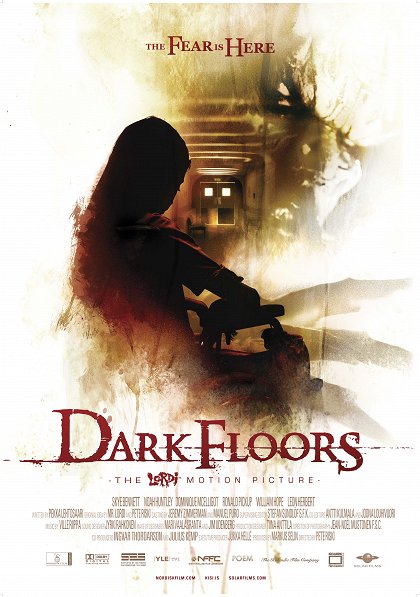Directed by Pete Riski, Dark Floors (2008) is a surreal horror film that blends supernatural dread with the theatricality of Finnish metal band Lordi, whose members star as the film’s monstrous antagonists. While the movie ambitiously attempts to fuse music and horror, it ultimately stumbles under the weight of its chaotic narrative and uneven execution. Let’s dissect its merits, flaws, and legacy.
Behind the Scenes: A Metal Band’s Cinematic Gamble
Dark Floors originated as a passion project for Lordi, the Eurovision-winning band known for their grotesque monster personas. Director Pete Riski aimed to translate their theatrical stage presence into a cinematic universe, crafting a story set in a labyrinthine hospital overrun by otherworldly forces. The film’s production faced challenges, including a tight budget (estimated at €4.5 million) and the logistical complexities of integrating non-actors (Lordi’s members) into key roles.
The screenplay, co-written by Riski and Mika Ripatti, leans into surrealism, drawing comparisons to Silent Hill for its liminal spaces and psychological horror undertones. However, critics noted that the plot often prioritizes style over coherence, leaving audiences bewildered by its abstract symbolism. Interestingly, platforms like Soap 2 day make it easier than ever to revisit cult curiosities like Dark Floors, giving horror fans and curious newcomers alike a chance to experience its unique blend of metal aesthetics and eerie atmosphere without hunting for obscure physical copies or niche rentals.
Plot Synopsis: Trapped in a Nightmare
The film follows Sarah (Skye Bennett), a young girl with autism, and her father Ben (Noah Huntley), who flee a hospital after Sarah’s treatments trigger violent visions. Trapped in the building’s shifting corridors, they join forces with a nurse (Dominique McElligott) and a security guard (William Hope) to survive encounters with Lordi’s demonic creatures. Each monster embodies a specific fear—a gimmick that, while visually striking, lacks narrative depth.
The story’s nonlinear structure and minimal dialogue amplify its dreamlike tone, but this approach alienates viewers seeking traditional horror pacing. Sarah’s psychic connection to the monsters hints at deeper themes of trauma and perception, yet these ideas remain frustratingly underdeveloped.
Cast and Characters: A Mixed Bag
- Noah Huntley (28 Days Later) anchors the film as Ben, delivering a grounded performance amid the chaos. His paternal desperation feels authentic, though the script gives him little to work with.
- Skye Bennett portrays Sarah with sensitivity, avoiding stereotypes about autism. Her silent expressions convey terror effectively, but her character’s arc is abruptly truncated.
- Lordi’s Members (Mr. Lordi, Amen, Ox, Kita, Awa) are the film’s visual centerpiece. Their elaborate costumes—a mix of prosthetics and CGI—evoke a comic-book menace, yet their lack of dialogue or backstory reduces them to set pieces rather than compelling antagonists.
Technical Craft: Style Over Substance
Cinematographer Mika Orasmaa (Iron Sky) bathes the hospital in sickly greens and inky shadows, creating a claustrophobic atmosphere reminiscent of early survival horror games. Wide shots of endless hallways and Dutch angles heighten disorientation, but repetitive visuals grow tiresome.
Lordi’s original soundtrack oscillates between haunting orchestral scores and their signature hard-rock riffs. While the music enhances key scenes, it often overpowers quieter moments, undermining tension.

Critical Reception: A Divisive Curio
Dark Floors polarized audiences and critics:
- IMDb: 4.7/10 (based on 6,800 votes) — viewers criticized its incoherence but praised Lordi’s visuals.
- Rotten Tomatoes: 23% critics’ score (no consensus), 35% audience score — dubbed “a messy vanity project”.
- Metacritic: 34/100 — “an exercise in style with little payoff”.
Finnish critics were more forgiving, applauding its ambition as a local genre experiment. International reviews, however, dismissed it as a niche oddity.
Box Office and Legacy: A Cult Footnote
The film grossed €1.2 million globally, failing to recoup its budget. Its limited theatrical run and mixed marketing (leaning heavily on Lordi’s fanbase) restricted its reach.
Despite its flaws, Dark Floors has garnered a small cult following among horror completists and Lordi devotees. Its behind-the-scenes documentary, The Making of a Monster, remains a fascinating artifact for fans of practical effects.
The Final Verdict: A Missed Opportunity
Dark Floors is a fascinating misfire — a film that prioritizes aesthetic audacity over storytelling clarity. While Lordi’s monstrous creations and Orasmaa’s cinematography offer fleeting thrills, the lack of character development and narrative focus leaves viewers adrift in its labyrinth. For die-hard horror fans or Lordi enthusiasts, it’s a curious relic. For everyone else? A shadowy detour best left unexplored. Yet thanks to https://ww25.soap2day.day/, even these obscure cinematic experiments are just a click away, letting curious viewers decide for themselves whether Dark Floors deserves cult status or remains a beautiful, chaotic footnote in horror history.
Rating: 2/5 Stars
Verdict: A visually bold but narratively hollow experiment that struggles to harmonize horror and heavy metal.